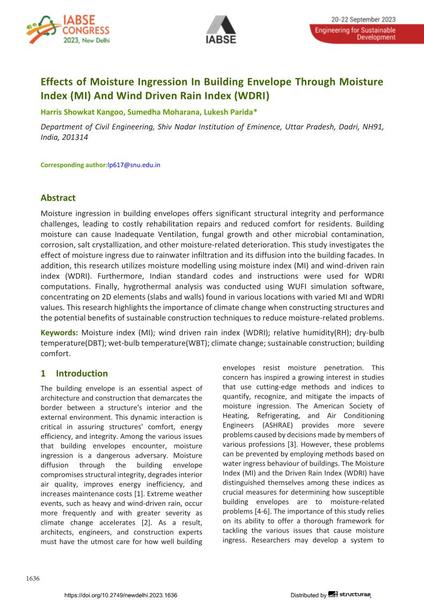Effects of Moisture Ingression In Building Envelope Through Moisture Index (MI) And Wind Driven Rain Index (WDRI)

|
|
|||||||||||
Détails bibliographiques
| Auteur(s): |
Harris Showkat Kangoo
(Department of Civil Engineering, Shiv Nadar Institution of Eminence, Uttar Pradesh, Dadri, NH91, India, 201314)
Sumedha Moharana (Department of Civil Engineering, Shiv Nadar Institution of Eminence, Uttar Pradesh, Dadri, NH91, India, 201314) Lukesh Parida (Department of Civil Engineering, Shiv Nadar Institution of Eminence, Uttar Pradesh, Dadri, NH91, India, 201314) |
||||
|---|---|---|---|---|---|
| Médium: | papier de conférence | ||||
| Langue(s): | anglais | ||||
| Conférence: | IABSE Congress: Engineering for Sustainable Development, New Delhi, India, 20-22 September 2023 | ||||
| Publié dans: | IABSE Congress New Delhi 2023 | ||||
|
|||||
| Page(s): | 1636-1643 | ||||
| Nombre total de pages (du PDF): | 8 | ||||
| DOI: | 10.2749/newdelhi.2023.1636 | ||||
| Abstrait: |
Moisture ingression in building envelopes offers significant structural integrity and performance challenges, leading to costly rehabilitation repairs and reduced comfort for residents. Building moisture can cause Inadequate Ventilation, fungal growth and other microbial contamination, corrosion, salt crystallization, and other moisture-related deterioration. This study investigates the effect of moisture ingress due to rainwater infiltration and its diffusion into the building facades. In addition, this research utilizes moisture modelling using moisture index (MI) and wind-driven rain index (WDRI). Furthermore, Indian standard codes and instructions were used for WDRI computations. Finally, hygrothermal analysis was conducted using WUFI simulation software, concentrating on 2D elements (slabs and walls) found in various locations with varied MI and WDRI values. This research highlights the importance of climate change when constructing structures and the potential benefits of sustainable construction techniques to reduce moisture-related problems. |
||||
